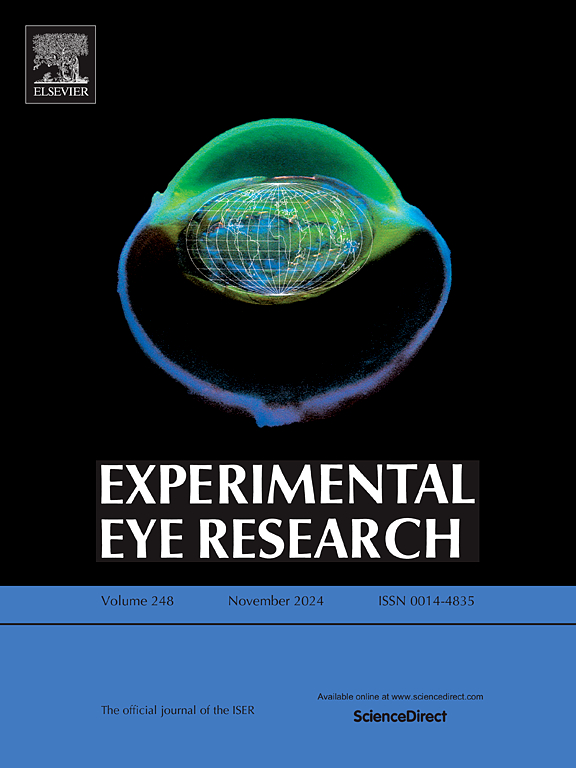Genomic analysis of glaucoma pathogenesis due to gmds mutation in zebrafish
IF 3
2区 医学
Q1 OPHTHALMOLOGY
引用次数: 0
Abstract
Glaucoma, a major cause of irreversible blindness, is characterized by optic nerve damage and loss of retinal ganglion cells (RGC). SNPs in the GDP-MANNOSE 4,6-DEHYDRATASE (GMDS) gene have been linked to primary open-angle glaucoma (POAG) and treatment responses. The GMDS gene plays a critical role in fucosylation, a process essential for modifying glycoproteins and glycolipids, yet no mechanism for its role in glaucoma pathology has been described. Our study investigates the effects of gmds haploinsufficiency using a CRISPR/Cas9 induced mutation in zebrafish. RNA sequencing (RNAseq) analysis shows significant downregulation of stress response genes including those of the crystallin family, and increased expression of cell death genes in gmds heterozygous mutant eyes. These gene expression changes correlate with phenotypic alterations, including RGC layer thinning, RGC loss, and reduced optic nerve head width in adult gmds heterozygotes relative to wild type siblings. Our findings provide new insights into the role of GMDS in regulating eye function and suggests that GMDS may influence glaucoma risk by regulating the response to stress. This study provides a layer of functional evidence supporting the predictions made by previous GWAS findings, enhancing our understanding of the genetic basis of glaucoma. It highlights the potential of GMDS as a therapeutic target for mitigating glaucoma-related vision loss, opening new avenues for glaucoma research and treatment development.
斑马鱼gmds突变致青光眼发病机制的基因组分析。
青光眼是不可逆性失明的主要原因,其特征是视神经损伤和视网膜神经节细胞(RGC)的丧失。甘露糖4,6-脱水酶(GMDS)基因的snp与原发性开角型青光眼(POAG)和治疗反应有关。GMDS基因在聚焦化中起关键作用,这是修饰糖蛋白和糖脂的必要过程,但其在青光眼病理中的作用机制尚未被描述。我们的研究使用CRISPR/Cas9诱导突变在斑马鱼中研究了gmds单倍不足的影响。RNA测序(RNAseq)分析显示,在gmds杂合突变眼中,包括晶体蛋白家族在内的应激反应基因显著下调,细胞死亡基因表达增加。这些基因表达变化与表型改变相关,包括与野生型兄弟姐妹相比,成年gmds杂合子的RGC层变薄、RGC丢失和视神经头宽度减小。我们的研究结果为GMDS在调节眼功能中的作用提供了新的见解,并表明GMDS可能通过调节对压力的反应来影响青光眼的风险。本研究提供了一层功能证据,支持先前GWAS研究结果的预测,增强了我们对青光眼遗传基础的理解。它突出了GMDS作为减轻青光眼相关视力丧失的治疗靶点的潜力,为青光眼的研究和治疗开发开辟了新的途径。
本文章由计算机程序翻译,如有差异,请以英文原文为准。
求助全文
约1分钟内获得全文
求助全文
来源期刊

Experimental eye research
医学-眼科学
CiteScore
6.80
自引率
5.90%
发文量
323
审稿时长
66 days
期刊介绍:
The primary goal of Experimental Eye Research is to publish original research papers on all aspects of experimental biology of the eye and ocular tissues that seek to define the mechanisms of normal function and/or disease. Studies of ocular tissues that encompass the disciplines of cell biology, developmental biology, genetics, molecular biology, physiology, biochemistry, biophysics, immunology or microbiology are most welcomed. Manuscripts that are purely clinical or in a surgical area of ophthalmology are not appropriate for submission to Experimental Eye Research and if received will be returned without review.
 求助内容:
求助内容: 应助结果提醒方式:
应助结果提醒方式:


